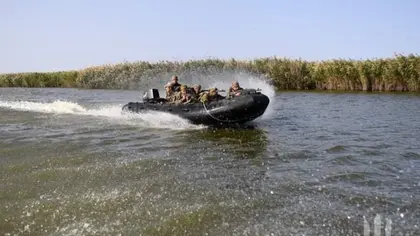Ukrainian Marines were, according to reports, digging in newly captured positions on the mostly Russian-held east side of the Dnipro River on Tuesday, with Kremlin-associated sources confirming the crossings took place – but vowing Russian air strikes and counterattacks would destroy the bridgeheads.
Ukrainian amphibious troops had in the past 24 hours occupied the village of Krynky, some 1.7 kilometers (~1 mile) inland from the Dnipro in Ukraine’s Kherson Region, both Russian and Ukrainian military information platforms said.
JOIN US ON TELEGRAM
Follow our coverage of the war on the @Kyivpost_official.
Russian troops were thin on the ground at the moment, so the Kremlin was hitting the 20-man Ukrainian detachment in Krynky with bombs and shells, pro-Moscow sources said.
Ukrainian military bloggers citing accounts from Marines on the ground said Kyiv troops now were holding positions successfully around three communities on the left bank of the southern flowing Dnipro River: Krynky, Pidstepne and Pishchanivka. It was not clear whether Ukrainian defenses were linked. All three localities are in a marshy and thickly wooded terrain.
According to previous Armed Forces of Ukraine (AFU) reports, Ukrainian commandoes have operated on the Dnipro River left bank since at least May, at times ambushing Russian troops and convoys.
The first transfer across the waterway of troops trained to take and hold ground, Ukraine’s 35th and 36th Marine Brigades, was widely reported on Oct. 18. The assault groups took up positions in Pidstepne and Pishchanivka, Armed Forces of Ukraine (AFU) said at the time.

Zelensky’s Top General Syrsky Admits Ukraine’s Army Faces Challenges – But Says Fixes Are Coming
The Washington-based Institute for the Study of War (ISW), in its Oct. 23 Ukraine situation update said Ukrainian forces on the left bank currently were retaining their positions but that Russia’s 58th Army was deploying troops to attack them.
Ukrainian media has widely reported Marine crossings of the Dnipro but generally described them as relatively small-scale terrain grabs that might be reinforced over time, or possibly evacuated.
A situation update from Ukraine’s 46th Mechanized Brigade, a unit operating in the southern sector, on Tuesday reported supply by small boats to the Ukrainian troops on the Dnipro left bank was running regularly, but frequently under fire.
Robert “Madyar” Brovdi, commander of a high-profile Ukrainian strike drone support unit supported by crowd-funding, on Monday published an appeal for donations to purchase zodiac-type assault boats to support Marine units fighting on the left bank of the Dnipro.
The Ukrainian infantry had only a few dozen 8-man Netherlands-manufactured craft available to support their bridgehead and they need at least 100 more boats each costing €3,150 (~$3,400), he said.
In a call for donations published in a professionally edited video published on his personal Telegram channel, Brovdi also proposed funding 50 HP Suzuki outboard engines and steering assemblies, batteries, cables, and life jackets and other equipment, pushing the full kit cost of each boat for Marine use to €8,790 (~$9,340).
In a Tuesday post, Brovdi reported about one-third of the required Hr.34.3 million (~$945,300) needed to fund the initiative had hit unit accounts in the first 12 hours following his appeal for support.
The Ukrainian military has enforced a near-total ban of independent media access to front-line AFU positions. Kyiv Post was unable to confirm reports of troop locations and combat in the Dnipro sector.
Ukrainian authorities on Monday ordered the “mandatory” evacuation of thousands of residents living in villages and towns along an 80+ kilometer (~50+ miles) stretch of the Dnipro River’s right bank (the west side). The order issued by the Kherson regional defense command also imposed martial law, banning civilian movement in at least 30 riverside localities from 8 p.m. to 6 a.m. Martial law practically bans independent observer access.
Kherson Regional Defense Commander Oleksandr Produkin, in a Telegram statement, said all families with children must leave their homes so that children might go to school out of range of Russian artillery. He did not say where the refugees might go but promised local authorities would assist.
By pre-war census counts, at least 45-50,000 people lived in some 30 riverside localities affected by the order.
Many were forced to flee their homes following the June demolition of a hydroelectric dam near the village of Kozatske. The wall of water released by demolition charges placed by Russian troops reportedly killed at least 58 people living in low-lying communities. Flood water subsided by late June, but not all residents returned to their homes.
Produkin named the following “settlements” as slated for evacuation: Dudchany, Kachkarovka, Milovoye, Novokairy, Zolota Balka, Mihailivka, Osokorivka, the city of Beryslav, Zmiivka, Novoberyslav, Tyaginka, Burhunka, Lvove, Mykolaivka, Odradokamyanka, Olhivka, Chervony Mayak, Vesilie, Kozatske, Antonivka, Kamyshany, Sadove and Priozernoye.
Ukrainian defense forces will remain in the region and protect abandoned civilian property, Produkin said. Russian forces on the other side of the river “can expect surprises” from Kyiv’s troops in coming days, he said.
You can also highlight the text and press Ctrl + Enter










